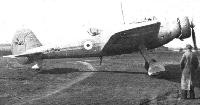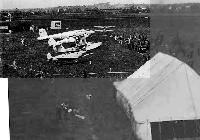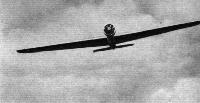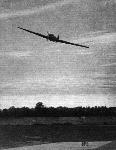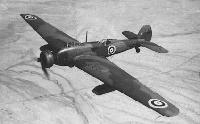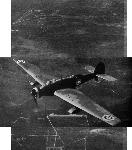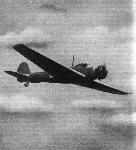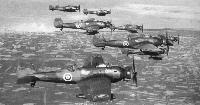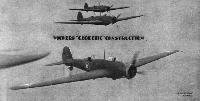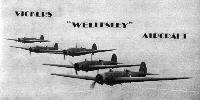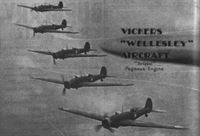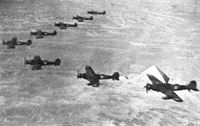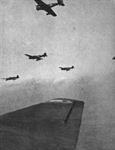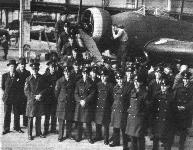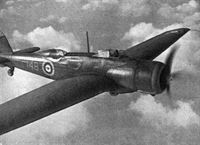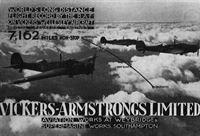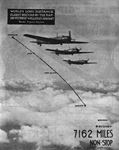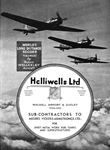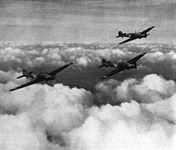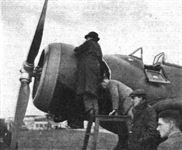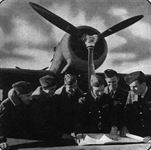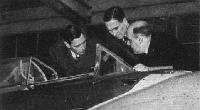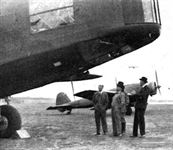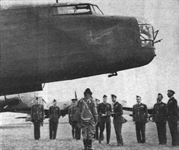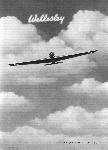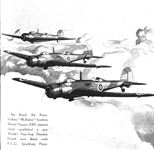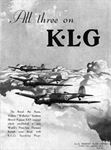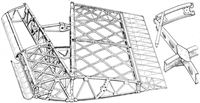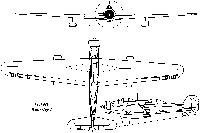
Wellesley
Дальний бомбардировщик, одномоторный цельнометаллический моноплан (с геодетическим каркасом и полотняной обтяжкой) с убирающимся шасси с хвостовым колесом. Экипаж 3 человека. Создан в КБ фирмы "Виккерс авиэйшн" под руководством Б. Уоллиса. Опытный самолет "тип 246" совершил свой первый полет 19 июня 1935 г. Серийное производство на заводе "Виккерс" в Бруклендсе начато в январе 1937 г. Изготовлено 176 экз.
Мотор "Пегасус" XX. Вооружение 2x7,69 (в полевых условиях доводилось до 3x7,69), бомбы до 910 кг в подкрыльных контейнерах.
Состоял на вооружении в Великобритании с апреля 1937 г.
Строились два основных варианта:
- "Уэллсли" I (тип 287);
- "Уэллсли" I (тип 294) с усиленным крылом.
С июня 1940 г. до ноября 1941 г. применялся из Судана и Адена против итальянцев в Эфиопии. До сентября 1942 г. служил как патрульный самолет на Красном море. "Уэллсли" сняли с производства в марте 1938 г., с вооружения - в конце 1942 г.
"Уэллсли" I||
Размах:||22,55 м
Длина:||11,92 м
Мотор, количество х мощность:||1x925 л.с.
Взлетная масса, максимальная:||5039 кг
Максимальная скорость:||364 км/ч
Практический потолок:||9500 м
Дальность:||2460 км
Описание:
- Wellesley
- Vickers Type 246 Wellesley
Фотографии
-
АвиаМастер 2000-02 / М.Никольский - Африканское эхо второй мировой /Неизвестная война/
Регистрационный номер: K7775 [2] "Уэллсли" из 47-й эскадрильи RAF, Судан, 1940г.
-
Air International 1980-07 / ??? - The Wellesley: geodetics in action /Warbirds/
The Type 246, Vickers' private venture to G.4/31, in its original form as completed in the early summer of 1935. This aircraft subsequently became the Type 281.
-
Flight 1935-11 / Flight
HIGH ASPECT RATIO is but one of the numerous outstanding features to be found in the new Vickers Wellesley medium bomber which has been ordered in quantity for the R.A.F. This machine made its first public appearance at the S.B.A.C. Display this year. The engine in the prototype is a Bristol Pegasus III 690/750 h.p. radial, but the production machines, it is now stated, will have a new type of Pegasus designated the Mk.XVIII. With full load the machine weighs about 10,000 lb.
-
Flight 1936-01 / Flight
The new medium bomber Vickers Wellesley (Bristol Pegasus XVIII) is a remarkable example of the manner in which geodetic construction makes possible a high aspect ratio coupled with low structure weight.
-
Flight 1935-07 / Flight
The Vickers monoplane bomber (Bristol "Pegasus") has a special type of construction in which curved diagonal members play an important part.
-
Flight 1935-07 / Flight
The retractable undercarriage of the Vickers monoplane was not completed in time to show it in its finished state.
-
Air Enthusiast 2006-11 / F.Prins - Adaptable Stalwart /World war two/ (1)
Both G4/31 interpretations performing at the Hendon Air Pageant, 1935. The G4/31 biplane (wearing the ‘New Types Park’ number 6) follows the monoplane PVO-9 ‘4‘.
Другие самолёты на фотографии: Vickers G.4/31 / Type 253 - Великобритания - 1934
-
Flight 1936-11 / Flight
Регистрационный номер: K7556 [7] -
Air Enthusiast 2006-11 / F.Prins - Adaptable Stalwart /World war two/ (1)
Регистрационный номер: K7556 [7] The prototype B22/45 Wellesley, K7556, differed considerably from the private venture monoplane
-
Air International 1980-07 / ??? - The Wellesley: geodetics in action /Warbirds/
Регистрационный номер: K7556 [7] The prototype Wellesley, after modification as the Type 281 and application of the serial K7556.
-
Aeroplane Monthly 1983-07 / D.Middleton - Jeffrey Quill /Test Pilot Profile/ (7)
Регистрационный номер: K7556 [7] The pre-production Vickers Wellesley K7556 in which Quill did a great deal of test work. The picture was taken at Martlesham Heath where the aircraft arrived for official trials during March 1936.
-
Jane's All the World Aircraft 1980 / Encyclopedia of Aviation - Aircraft A-Z - v5
Регистрационный номер: K7556 [7] K5054 был впервые показан 300 приглашенным гостям 18 июня 1936 года на демонстрации самолетов фирмы "Vickers" в Истли, На снимке: K4049 - прототип бомбардировщика В.9/32 (позднее служившего под именем Wellington); K7556 - предсерийный бомбардировщик Wellesley и K5780 - девятая серийная амфибия Walrus. В 1938 году "Supermarine Aviation Works (Vickers) Ltd" и ее головная компания "Vickers (Aviation) Ltd of Weybridge" объединились в фирму "Vickers-Armstrong Limited".
Supermarine Spitfire prototype on view to the public in 1936 alongside a Walrus, the prototype Wellesley and prototype Wellington.Другие самолёты на фотографии: Supermarine Spitfire - Великобритания - 1936Supermarine Walrus/Seagull V - Великобритания - 1933Vickers Wellington / Type 271 - Великобритания - 1936
-
Flight 1936-02 / Flight
The Vickers "Wellesley" medium bomber (Pegasus XVIII), in which the famous geodetic construction system is employed, is another type for which a considerable order has been placed.
-
Flight 1936-06 / Flight
The Wellesley with Bristol Pegasus engine and is of "geodetic" construction.
-
Flight 1936-07 / Flight
Регистрационный номер: K7556 [7] MARTLESHAM'S GREAT DAY: It must have been extremely gratifying to Martlesham that the King should show such interest in the work of the station and in some of the very latest military machines now on test there. In this view, His Majesty, after inspecting the Vickers Wellesley, is passing to the next machine in the line-up,
-
Air International 1980-07 / ??? - The Wellesley: geodetics in action /Warbirds/
Регистрационный номер: K7716 The fourth production Wellesley (K7716), one of the eight completed to Type 287 standard
-
Air International 1980-07 / ??? - The Wellesley: geodetics in action /Warbirds/
Регистрационный номер: K7729 The 17th production Wellesley (K7729).
-
АвиаМастер 2000-02 / М.Никольский - Африканское эхо второй мировой /Неизвестная война/
"Уэллсли" из 14-й эскадрильи взлетает с полевого аэродрома Кассала в Судане.
-
Aeroplane Monthly 1984-12 / L.Coombs - The expanding years 1936-1939 (2)
Регистрационный номер: K7721 Wellesley K7721 of the first production batch spent a period with the RAE before being issued to 148 Squadron. No 76 Squadron was the first unit to receive the type into service, the first aircraft arriving at Finningley in April 1937.
-
Flight 1936-09 / Flight
Регистрационный номер: K7556 [7] LONG-RANGE ARTILLERY: The Vickers Wellesley, thanks to the merits of geodetic construction, can destroy targets at an abnormal distance from its base.
-
Моделист-Конструктор Бомбардировщики Второй мировой войны
Регистрационный номер: K7718 [6] Шестой серийный "Уэллсли" I, 1937г.
-
Aeroplane Monthly 1979-04 / F.Adkin - Memoirs of Aircraftsman (4)
Регистрационный номер: K7718 [6] -
Aeroplane Monthly 1986-01 / R.Nesbit - The Allied Plan to Bomb Russia (2)
Регистрационный номер: K7718 [6] The Allied assault force on Russian oilfields would have included a squadron of Wellesleys, on photo, and four squadrons of Bristol Blenheim IVs.
-
Flight 1937-04 / Flight
The Vickers Wellesley, intended for general purpose work and long-range bombing operations. The engine is a Pegasus.
-
Jane's All the World Aircraft 1938 / 03 - All the world's aeroplanes
The Vickers "Wellesley" Long-range Bomber Monoplane (Bristol "Pegasus" engine).
-
Aeroplane Monthly 1984-03 / J.Pelly-Fry - Wellesleys over the Sudan (1)
Регистрационный номер: L2673 [2] Wellesley L2673 of 223 Sqn over Mount Kenya, East Africa, c.1938-40. L2673 subsequently passed to 47 Sqn and the Communications Flight at Khartoum before finally being struck off RAF charge in October 1943.
-
Air Enthusiast 2006-11 / F.Prins - Adaptable Stalwart /World war two/ (1)
Регистрационный номер: L2645 [2] Production Wellesley I L2645 was delivered to 14 Squadron in early 1938.
-
Flight 1940-12 / Flight
A Vickers Wellesley (Pegasus) of the type which set up a world's record of 7,158 miles, non-stop.
Great aerodynamic and structural efficiency, due to the system of geodetic construction employed, makes the Vickers Wellesley a most formidable long-range bomber. Pegasus X, XVII and XX engines have been specified. -
Flight 1937-08 / Flight Advertisements
The Vickers "Wellesley" Long-range Bomber Monoplane. Note the streamline bomb-containers beneath the wings.
-
Aeroplane Monthly 1984-03 / J.Pelly-Fry - Wellesleys over the Sudan (1)
Регистрационный номер: K7726 [2] Wellesley K7726 served with Nos 76, 47 and 148 Squadrons before being struck off RAF charge in July 1944.
-
Flight 1937-11 / Flight
Регистрационный номер: K7726 [2] A POTENTIAL CHAMPION: A Vickers Wellesley medium bomber (Pegasus XX) complete with streamline bomb-carriers below its wings. It is possible that a specially prepared Wellesley may try for the world's long-distance record.
-
Моделист-Конструктор Бомбардировщики Второй мировой войны
"Уэллсли" I, оснащенный противопыльным фильтром, Восточная Африка, 1941 г.
-
Flight 1938-07 / Flight Advertisements
Регистрационный номер: K7718 [6] -
Flight 1937-06 / Flight
Регистрационный номер: K7718 [6] Capable of flying for very long distances at a high cruising speed, the Vickers Wellesley has been adopted for general purpose and bombing duties.
-
Aeroplane Monthly 1984-05 / J.Pelly-Fry - Wellesleys over the Sudan (3)
Регистрационный номер: K7718 [6] Дальний бомбардировщик "Уэллсли". На эти машины англичане возлагали большие надежды в начале восточно-африканской кампании.
This picture give some idea of the massive span of the Wellesley's wing. -
Flight 1937-04 / Flight Advertisements
"Wellesley" ("Bristol" Pegasus Engine) VICKERS "GEODETIC" CONSTRUCTION
-
Flight 1938-03 / Flight
Vickers Wellesley
-
Flight 1938-05 / Flight
VICKERS WELLESLEY: Bomber (Pegasus XX engine - 925 h.p, at 10,000ft.); span, 74ft. 7in.; gross weight, 12,500 lb.; max. speed, 220 m.p.h. (approx.) at 10,000ft.
-
Air International 1980-07 / ??? - The Wellesley: geodetics in action /Warbirds/
Регистрационный номер: K7775 [2] A Wellesley (K7775 KU-N) of No 47 Squadron, which had received its aircraft from No 45 Squadron in the Middle East and began its, war at Khartoum, then moving to Erkowit and flying its first bombing mission on 11 June 1940.
-
Авиация и Время 2014-03 / Н.Терец, А.Хаустов - Британский солдат "Веллингтон-Вимпи"
«Уэлсли» стал первым бомбардировщиком «Виккерс» с «геодезической» конструкцией
-
Aeroplane Monthly 1984-03 / J.Pelly-Fry - Wellesleys over the Sudan (1)
Wellesley "B” of 223 Squadron flying over the home-made air-firing target set into the side of a hill. Despite the author's wager no air gunner ever succeeded in getting more than five rounds (out of a pan of 97) on the 25ft square target.
-
Flight 1940-12 / Flight
Although the Vickers Wellesley was designed as a general purpose machine, few people know that it has been used for dropping torpedoes.
-
Aeroplane Monthly 1984-03 / J.Pelly-Fry - Wellesleys over the Sudan (1)
The pilot's view from a Wellesley, looking along the port wing and with the pitot head for the airspeed indicator out at the tip. Of interest is the way that the fabric on the upper surface of the wing has been sucked upwards, thus showing the outline of the geodetic construction on each side of the main spar.
-
Jane's All the World Aircraft 1938 / 02 - The progress of the world in military aviation during the year 1937-38
Vickers "Wellesleys" (Bristol "Pegasus") in flight formation over their home aerodrome at Finningley. No 76 (B) Squadron was the first to be armed with this machine. "Wellesleys" are used by the Long Range Development Flight.
-
Мировая Авиация 249
Регистрационный номер: K7783 К началу Второй мировой войны Wellesley уже существенно устарел, однако самолеты все же активно применялись в боевых действиях на Ближнем Востоке и в Африке. Данные Wellesley Mk I запечатлены над Египтом.
-
АвиаМастер 2003-01 / А.Степанов - Кавказский вариант: англо-французские планы воздушного нападения на СССР в 1939-1940гг. /Тайны секретных архивов/
Английские дальние бомбардировщики Виккерс "Уэллсли" над пирамидами Египта. Эти машины могли быть задействованы в бомбардировке кавказских нефтепромыслов.
-
Air International 1980-07 / ??? - The Wellesley: geodetics in action /Warbirds/
The Wellesleys of No. 76 in “open order.” The appendages beneath the wings, which might puzzle the uninitiated, are bomb containers.
-
Aeroplane Monthly 1984-04 / J.Pelly-Fry - Wellesleys over the Sudan (2)
A formation of 76(B) Squadron Wellesleys up from RAF Finningley in February 1938. No 76 Squadron was the first unit to receive the Wellesley into service, at Finningley in April 1937, and the type was still on strength at the outbreak of war.
-
Jane's All the World Aircraft 1938 / 02 - The progress of the world in military aviation during the year 1937-38
A Formation of Vickers "Wellesley" Bombers flying over the desert in Egypt.
-
Flight 1940-08 / Flight
The A.O.C-in-C. has, in the Vickers Wellesley, a bomber of very long range.
-
Aeroplane Monthly 1983-06 / ??? - 'Planes and pyramids
Vickers Wellesleys over Egypt in 1940.
-
Flight 1938-07 / Flight
DESERT FORMATION: No. 45 (B.) Squadron, the first in the Middle East to be equipped with Vickers Wellesleys, are stationed at Helwan, Egypt. The specially prepared long-range Wellesleys may soon be in Egypt, and Ismailia has been named as a possible take-off point for Australia.
-
Flight 1937-10 / Flight
A fly-past at Mildenhall, for the benefit of the guests, by a squadron of Vickers Wellesleys with their external "egg-boxes."
-
Flight 1938-03 / Flight
No. 76 (B) Squadron was the first to have the Vickers Wellesley medium bomber.
-
Jane's All the World Aircraft 1980 / Encyclopedia of Aviation - Aircraft A-Z - v5
Vickers Wellesley Is.
-
Flight 1938-03 / Flight
Looking, in a way, unfamiliar with undercarriages extended - the Wellesleys taking off from Finningley.
-
Aeroplane Monthly 1979-04 / F.Adkin - Memoirs of Aircraftsman (4)
Регистрационный номер: K7722, K7725 Vickers Wellesley single-engined bombers (Pegasus XX). The Wellesley, although a "general purpose" type, equips the Long-Range Development Flight.
Wellesleys of 76 Squadron lined up in readiness for the 1938 RAF display at Hendon. Nearest are K7722 and K7725. -
Flight 1937-12 / Flight Advertisements
Регистрационный номер: K7715 -
Flight 1937-10 / Flight
Регистрационный номер: K7733 [2] ASPECT RATIO: Vickers Wellesleys of a unit which demonstrated before our German guests at Mildenhall.
-
Flight 1938-04 / Flight
This photograph, taken at Hendon before the last R.A.F. display, is a history of production in itself, for the types shown range from the Virginia to modern Expansion bombers.
Другие самолёты на фотографии: Bristol Blenheim - Великобритания - 1936Handley Page Harrow / H.P.54 - Великобритания - 1936Vickers Virginia - Великобритания - 1922
-
Flight 1938-01 / Flight
VICKERS WELLESLEY medium bombers, complete with bomb carriers, awaiting the arrival of Service pilots to ferry them to depots or squadrons
-
Aeroplane Monthly 1984-03 / J.Pelly-Fry - Wellesleys over the Sudan (1)
Пилот в кабине "Уэллсли" перед вылетом на боевое задание.
The intrepid Flt Cdr of “A "Flight, 223 Squadron, about to go flying in his favourite mount, Wellesley AO-A. -
Aeroplane Monthly 1984-05 / J.Pelly-Fry - Wellesleys over the Sudan (3)
A 47 Squadron Wellesley being serviced for its next sortie. Note the four-gallon Shell tins, that leaked so badly, and the bombs lying carelessly on the ground.
-
Flight 1937-04 / Flight
GEOGRAPHY AND GEODETICS: Vickers aircraft (on the marine side, at all events) are well known to men of the Royal Australian Air Force, so it was with keen interest that this Coronation contingent inspected the Weybridge works last week. They are seen in front of a Wellesley.
-
Flight 1938-03 / Flight
Pilots of No. 76 (B) Squadron. Left to right (front row): P/O. J. S. Sherwood, P/O. J. T. B. Sadler, Sgt. S. W. Jenkins, P O. W. D. Corr, P/O. J. E. Riepenhausen, P/O. J. M. Warren, Flt. Lt. Isemonger, Sqn. Ldr. L. E. J. George (Commanding Officer), F/O. L. R. Stewart, P/O. P. H. Rebbeck, P/O. F. L. Chadwick, P/O. J. N. Culverwell, P/O. C. A. Baskett. Back row: Flt. Sgt. E. G. Couch, P/O. G. K. Peacock, P/O. B. P. Jones.
-
АвиаМастер 2000-02 / М.Никольский - Африканское эхо второй мировой /Неизвестная война/
"Уэллсли" из 47-й эскадрильи на аэродроме Белайя, февраль 1941г.
-
Aeroplane Monthly 1979-04 / F.Adkin - Memoirs of Aircraftsman (4)
Регистрационный номер: K8530 An aerial camera being taken aboard Wellesley K8530 of B Flight, 35 Squadron, at RAF Worthy Down. The port underwing bomb container is just visible.
-
Air Enthusiast 1994-09 / A.Wood - Airline at War
Регистрационный номер: L2714 Wellesley L2714 of 223 Squadron at Khartoum, 1940.
-
Aeroplane Monthly 1984-05 / J.Pelly-Fry - Wellesleys over the Sudan (3)
Flt Lt “Digger” Magill returns from a sortie against the Italian ground forces in the Gallabat-Metemina area. Sundry Army, RAF and Sudan Government officers get a first-hand account of the progress in the battle.
-
Aeroplane Monthly 1987-08 / D.Stapleton - "No blame attaches..." (1)
Регистрационный номер: L2645 [2] Vickers Wellesley L2645 served with 47 Sqn, one of two Sudan-based Wellesley units pitted against the Italian destroyer flotillas. Photographed in 1942 at St Jean, Palestine.
-
Aeroplane Monthly 1984-03 / J.Pelly-Fry - Wellesleys over the Sudan (1)
At the Summit landing ground in 1940. Sqn Ldr R. T. Taaffe (officer commanding 223 Squadron) with his back to the camera, talks to a visitor who has arrived in Anson I L9145 from Khartoum. A 47 Squadron Wellesley can be seen in the background.
Другие самолёты на фотографии: Avro Anson / Type 652 - Великобритания - 1935
-
Air International 1980-07 / ??? - The Wellesley: geodetics in action /Warbirds/
Регистрационный номер: L2637 One of the Wellesleys (L2637) assigned to the LRDU. This particular machine was the back-up aircraft and did not participate in the Unit's long-distance flights.
-
Air Pictorial 1958-10
Регистрационный номер: L2638 [3] These photographs show the arrival of Wellesleys L2638 and L2680 at Ismailia from Upper Heyford, prior to the take-off on the long-distance record attempt to Darwin, Australia, on 5th to 7th November 1938. After service three machines (L2639) set off at 0555 local time (0355 G.M.T.) piloted by S/Ldr. Kellett. F/Lt. Hogan and F/Lt. Coobine. Photo: L2638.
-
Air Enthusiast 1996-05 / C.Owers - Long Ranging Thoughts. LRDU Wellesleys to Australia
Регистрационный номер: L2680 [3] L2680 after the bomb panniers had been fitted at Laverton, Victoria.
-
Flight 1938-11 / Flight Advertisements
A Rotol constant-speed airscrew, hydraulic type, on the Bristol Pegasus XXII of a Vickers Wellesley.
-
Flight 1938-11 / Flight
Регистрационный номер: L2673 [2] A side view of one of the long-range Wellesleys showing that the fuselage is comparatively short in relation to the wing span. The special cowling and fairing arrangements may be noted.
-
Air Enthusiast 1996-05 / C.Owers - Long Ranging Thoughts. LRDU Wellesleys to Australia
Регистрационный номер: L2639 [3] L2639 probably at RAAF Richmond, NSW.
-
Air Enthusiast 1996-05 / C.Owers - Long Ranging Thoughts. LRDU Wellesleys to Australia
Регистрационный номер: L2639 [3] L2639 with panniers fitted. This view gives a good idea of the size of the aircraft.
-
Air Enthusiast 1996-05 / C.Owers - Long Ranging Thoughts. LRDU Wellesleys to Australia
Регистрационный номер: L2638 [3] Refuelling L2638 on a country airstrip.
-
Air Pictorial 1958-10
Регистрационный номер: L2680 [3] These photographs show the arrival of Wellesleys L2638 and L2680 at Ismailia from Upper Heyford, prior to the take-off on the long-distance record attempt to Darwin, Australia, on 5th to 7th November 1938. After service three machines (L2639) set off at 0555 local time (0355 G.M.T.) piloted by S/Ldr. Kellett. F/Lt. Hogan and F/Lt. Coobine. Photo: L2680
-
Aviation Historian 25 / G.Baughen - The case for appeasement?
Регистрационный номер: K7717 [4] The unusual single-engined Vickers Wellesley, incorporating extremely high-aspect-ratio wings, entered RAF service with No 76 Sqn in April 1937. Capable of carrying a bomb-load of 2,000lb (910kg), the type served with ten squadrons at home and overseas, including No 148 Sqn, with which this example, K7717, served during 1937.
-
Aeroplane Monthly 1984-03 / J.Pelly-Fry - Wellesleys over the Sudan (1)
Регистрационный номер: K7717 [4] Wellesley K7717 was a trial aircraft for the Long Range Development Flight. This, the fifth production aircraft, initially flew with 45(B) Squadron in Egypt, powered with a Pegasus XVIII, and later flew as a testbed for the Pegasus XXII. It was struck off RAF charge in May 1938.
-
Flight 1938-10 / Flight
Регистрационный номер: K7717 [4] LONG-RANGE MODS: If everything goes according to plan the Long-Range Development Flight of the R.A.F. should now be on their way to Australia with four Vickers Wellesleys. This view (actually of a machine loaned by the Air Ministry to the Bristol Company for engine tests) shows how the long-range type differs from the standard model. It will be seen that the Pegasus XXII engine is more carefully faired.
-
Air International 1980-07 / ??? - The Wellesley: geodetics in action /Warbirds/
Регистрационный номер: K7717 [4] The fifth production Wellesley (K7717) utilised as a trials aircraft for the Long Range Development Unit after brief service with No 148 Squadron. Note NACA-type cowling and new front fuselage fairing.
-
Air Enthusiast 1996-05 / C.Owers - Long Ranging Thoughts. LRDU Wellesleys to Australia
Two Vickers Wellesleys over the Australian countryside.
-
Flight 1938-11 / Flight
RECORD BREAKERS IN TRIPLICATE: The three Vickers Wellesley monoplanes (special Bristol Pegasus XXII) of the Long Range Development Flight which have added so much lustre to the name of the R.A.F. as a record-breaking service by eclipsing the world’s long-distance record.
-
Flight 1938-11 / Flight
THE LONG-RANGE WELLESLEYS at Ismailia before their record flight.
-
Flight 1938-07 / Flight
Ministering to the Pegasus in the experimental Wellesley at Filton. The clean design of the Rotol airscrew is apparent.
-
Flight 1938-11 / Flight Advertisements
The Rotol Constant Speed Airscrews fitted io the three Vickers "Wellesley" machines for the record-breaking long-range flight incorporated airscrew blade forgings in MAGNUMINIUM Magnesium Base Alloy By HIGH DUTY ALLOYS LTD., SLOUGH
-
Flight 1938-11 / Flight
5-7 ноября 1938г.: два бомбардировщика Vickers Wellesley британских ВВС, пилотируемые сквадрон-лидером Р. Келлеттом и флайт-лейтенантом Э. Комбом, установили мировой рекорд дальности, пролетев 11520 км из Исмаилии (Египет) до аэропорта Росс-Смит (Австралия).
The personnel of the Long-Range Development Unit: (Standing, left to right), Sgt. J. H. Houghton, Flt. Lt. G. T. Gething,* Pilot Officer M. L. Gaine,* Sgt. H. B. Gray,* Sgt. T. D. Dixon,* Flt. Lt. B. K. Burnett,* Flt. Lt. R. G. Musson,* Flt. Lt. A. T. D. Sanders. (Sitting, left to right), Flt. Lt. A. N. Combe,* Sqn. Ldr. R. Kellett* (Flight Leader), Wing Cdr. O. R. Gayford, D.F.C., A.F.C. (Officer Commanding Long-Range Development Unit), Flt. Lt. H. A. V. Hogan,* Flt. Lt. P. H. Dunn. Asterisks denote those who took part in the actual flight. -
Air International 1980-07 / ??? - The Wellesley: geodetics in action /Warbirds/
Регистрационный номер: K7772 This early production Wellesley (K7772) was set aside for use as a testbed for the Bristol Hercules HE.1S sleeve-valve engine. This aircraft subsequently played a major role in the flight development of the Hercules which was to take a noteworthy part in World War II, this engine eventually being applied to the Wellington, development of which had run parallel with Wellesley production.
-
Flight 1937-12 / Flight
THE LONG-RANGE WELLESLEY: H.M. the King, during his tour of aircraft factories last week, was shown the long-range Wellesley in the Vickers works. It will be seen that the nose of the machine has been modified as compared with that of the standard Wellesley.
-
Flight 1937-12 / Flight
At Brooklands: The King took particular interest in the Wellesley, which will be the research machine for the new R.A.F. Long-distance Flight. He is seen with Mr. T. C. L. Westbrook and (right) Mr. Rex Pierson.
-
Flight 1937-10 / Flight
General Milch, at Mildenhall, watches a demonstration by a gunner in the rear cockpit of a Wellesley.
-
Flight 1938-09 / Flight
The Air Minister is seen under the imposing nose of a Wellington, with a Wellesley in the background. On the left is Sir Robert McLean, chairman of Vickers Aviation Ltd.
Другие самолёты на фотографии: Vickers Wellington / Type 271 - Великобритания - 1936
-
Flight 1938-05 / Flight
The King inspects machines of the Bomber Group. Above him towers the nose of a Harrow, and behind can be distinguished a Whitley, Wellesley and Blenheim.
Другие самолёты на фотографии: Armstrong Whitworth Whitley / A.W.38 - Великобритания - 1936Bristol Blenheim - Великобритания - 1936Handley Page Harrow / H.P.54 - Великобритания - 1936
-
Aeroplane Monthly 1989-10 / Personal album. Civil
A last look at peacetime Croydon from the airport buildings. War clouds loom - note the two RAF Wellesleys parked just in front of the distant hangars.
-
Aeroplane Monthly 1984-05 / J.Pelly-Fry - Wellesleys over the Sudan (3)
The pilot's view from a Wellesley. The ring and bead sight was harmonised, so it was said, with the single Vickers .303 machine gun in the starboard wing. Apart from unsuccessfully shooting 15ft crocodiles on the Blue Nile the gun served no useful purpose whatever.
-
Aeroplane Monthly 1984-03 / J.Pelly-Fry - Wellesleys over the Sudan (1)
A self-portrait of the author taken with his newly acquired 35mm wide angle Leica lens. As the Wellesley cockpit was draught free, pilots usually flew with the hood open. This photograph was taken at about 10,000ft above the Northern Sudan.
-
Aeroplane Monthly 1984-03 / J.Pelly-Fry - Wellesleys over the Sudan (1)
Регистрационный номер: L2680 [3] In Wellesley L.2680: Sgt. H. B. Gray, who kept wireless contact for weather warnings and sent progress reports.
Sgt H. B. Gray, wireless operator of Wellesley L2680 on the Long Range Development Unit, pictured in his aircraft. Sgt Gray kept radio contact for weather warnings and sent progress reports.
-
Aeroplane Monthly 1979-05 / F.Adkin - Memoirs of Aircraftsman (5)
“Finger trouble" is given as the cause of the accident to this Wellesley of “B” Flight, 35 Squadron, which overshot and nosed into a ditch, sustaining superficial damage. It was back in the hangar 55min later.
-
Aeroplane Monthly 1979-04 / F.Adkin - Memoirs of Aircraftsman (4)
Регистрационный номер: K7748 K7748 after a typical undercarriage failure with 35 Squadron. Note the manner in which the leg has pushed the tank up out of the wing. This aircraft was lost at sea en route to the Middle East on September 6, 1939.
-
Aeroplane Monthly 1984-04 / J.Pelly-Fry - Wellesleys over the Sudan (2)
Регистрационный номер: K7760 Somewhere in the Sudan - probably Sennar. Fg Off Jock Sheppard of “A” Flight, 223 Squadron, surveys his Wellesley, K7760, after it forced landed immediately after take-off on November 29, 1940. The cause of the engine failure is not known. The Pegasus XX has detached itself from the aircraft.
-
Aeroplane Monthly 1979-04 / F.Adkin - Memoirs of Aircraftsman (4)
Регистрационный номер: K7751 Another 35 Squadron aircraft, K7751, which suffered leg failure during camp at West Freugh in January 1938.
-
Air Enthusiast 1996-05 / C.Owers - Long Ranging Thoughts. LRDU Wellesleys to Australia
Регистрационный номер: L2638 [3] L2638 after its forced-landing on November 28, 1938, after its Rotol control for the airscrew ran away.
-
Aeroplane Monthly 1984-05 / J.Pelly-Fry - Wellesleys over the Sudan (3)
Jock Shepperd's 223 Squadron Wellesley, AO-K, after collapsing onto the ground at the end of its sortie. Sundry holes result from the attentions of Pedro, “the Spanish Ace”, in his CR.42. Note the non-standard inter-cockpit glazed canopy and the loop aerial. The pictures were taken at the Summit Landing Ground in June 1940.
-
Aeroplane Monthly 1984-04 / J.Pelly-Fry - Wellesleys over the Sudan (2)
Регистрационный номер: K7733 [2] Two views of Wellesley K7733 after a take-off accident at Blackdown, Sudan on November 6, 1940. The fact that both landing lights are in the extended position indicates that the incident probably occurred at night.
-
Air Enthusiast 1996-05 / C.Owers - Long Ranging Thoughts. LRDU Wellesleys to Australia
Регистрационный номер: L2639 [3] L2639 after its forced-landing, taken from Heffernan’s Anson.
Другие самолёты на фотографии: Avro Anson / Type 652 - Великобритания - 1935
-
Aeroplane Monthly 1979-04 / F.Adkin - Memoirs of Aircraftsman (4)
Регистрационный номер: K7738 The sad remains of K7738 after its fatal crash at New Leak, Lincs, on October 20, 1937. There were no survivors.
-
Flight 1938-09 / Flight Advertisements
Регистрационный номер: L2636 -
Aeroplane Monthly 1991-08
First flight of the Vickers Wellesley: August 16, 1934
-
Air International 1980-07 / ??? - The Wellesley: geodetics in action /Warbirds/
Vickers Wellesley Mk I
-
Flight 1938-12 / Flight
In a class of structure by itself is the Vickers-Wallis geodetic construction. The members, run diagonally around the surface, and tension members are made to stabilise compression members, and vice versa.
-
Air International 1980-07 / ??? - The Wellesley: geodetics in action /Warbirds/
The side profile drawings depict (top to bottom) the prototype Wellesley in its original form (1935); the prototype after reconstruction as the Type 281 (1936); the three-seat Type 402 Wellesley; the LRDF Type 292 Wellesley, and the Type 289 Wellesley Hercules test-bed.
-
Моделист-Конструктор Бомбардировщики Второй мировой войны
Vickers Wellesley I
-
Air International 1980-07 / ??? - The Wellesley: geodetics in action /Warbirds/
The general arrangement drawing depicts the standard Wellesley Mk I.
Тип фотографий
- Все фото (136)
- Боковые проекции (1)
- Ч/б фото (109)
- Кабина (3)
- Обломки (9)
- Рисунки, схемы, чертежи (14)








